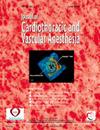胸外科手术中肺分离时吸氧比例低与高:一项随机对照试验。
IF 2.3
4区 医学
Q2 ANESTHESIOLOGY
Journal of cardiothoracic and vascular anesthesia
Pub Date : 2025-03-20
DOI:10.1053/j.jvca.2025.03.031
引用次数: 0
摘要
目的:通过动脉血氧分压(PaO2)/FiO2比值评估肺分离早期较低的吸入氧(FiO2)分数是否能够改善血液的整体氧合,并探讨其对肺衰竭和术后肺并发症(PPC)的影响。设计:前瞻性、非盲法、随机对照试验。环境:大学医院的单中心试验。参与者:需要单肺通气(OLV)的胸外科手术患者。干预措施:研究参与者在肺分离后接受低氧然后增加的氧浓度或纯氧然后降低氧浓度。测量和主要结果:主要终点为OLV开始后30分钟的PaO2/FiO2比值。次要终点包括OLV早期无肺萎陷、部分肺萎陷或完全肺萎陷,以及PPC的发生率。共纳入55例患者,其中53例纳入分析。两组的主要终点PaO2/FiO2比值具有可比性,次要终点肺萎陷也相似。然而,低氧含量策略显著降低了PPC的发病率(19% vs 48%;P = 0.042)。结论:肺分离前后的低FiO2策略并没有提高肺的氧合能力,肺衰竭在两个研究组中具有可比性。然而,低FiO2处理组PPC的发生明显减少。本文章由计算机程序翻译,如有差异,请以英文原文为准。
Low versus High Fraction of Inspired Oxygen During Lung Separation in Thoracic Surgery: A Randomized Controlled Trial
Objectives
To investigate whether a lower fraction of inspired oxygen (FiO2) during the early phase of lung separation is able to improve overall oxygenation of the blood assessed by the arterial partial pressure of oxygen (PaO2)/FiO2 ratio, and to investigate its effect on lung collapse and postoperative pulmonary complications (PPC).
Design
Prospective, nonblinded, randomized controlled trial.
Setting
Single-center trial at a university hospital.
Participants
Patients scheduled for thoracic surgery requiring one-lung ventilation (OLV).
Interventions
Study participants received either a low and then increasing oxygen concentration after lung separation or pure oxygen and then a decreasing oxygen concentration.
Measurements and Main Results
The primary endpoint was the PaO2/FiO2 ratio 30 minutes after the start of OLV. Secondary endpoint included lung collapse defined as none, partial, or complete during the early phase of OLV and incidence of PPC. A total of 55 patients were enrolled, 53 of whom were included in the analysis. The primary endpoint, PaO2/FiO2 ratio, was comparable in the 2 groups, and the secondary endpoint, lung collapse, was similar. However, the incidence of PPC was significantly reduced with a low oxygen content strategy (19% vs 48%; p = 0.042).
Conclusions
A strategy of low FiO2 before and after lung separation did not improve the oxygenation capacity of the lungs, and lung collapse was comparable in the 2 study groups. However, the occurrence of PPC was significantly reduced in the group treated with low FiO2.
求助全文
通过发布文献求助,成功后即可免费获取论文全文。
去求助
来源期刊
CiteScore
4.80
自引率
17.90%
发文量
606
审稿时长
37 days
期刊介绍:
The Journal of Cardiothoracic and Vascular Anesthesia is primarily aimed at anesthesiologists who deal with patients undergoing cardiac, thoracic or vascular surgical procedures. JCVA features a multidisciplinary approach, with contributions from cardiac, vascular and thoracic surgeons, cardiologists, and other related specialists. Emphasis is placed on rapid publication of clinically relevant material.

 求助内容:
求助内容: 应助结果提醒方式:
应助结果提醒方式:


